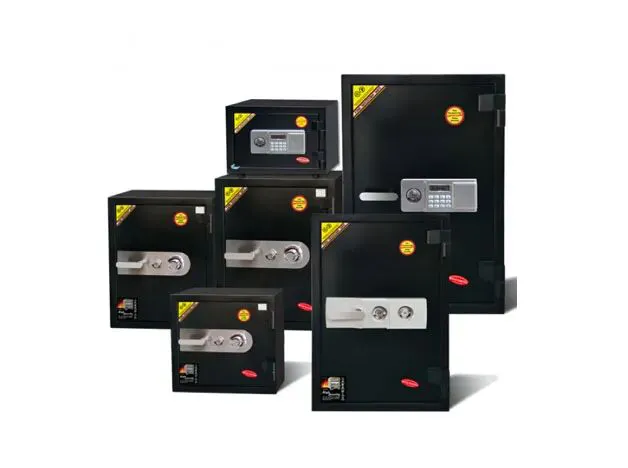Welcome to China Singdu Cabinets Manufacturer!
Gun ownership comes with a significant responsibility: proper storage and maintenance. One of the most critical aspects of this is protecting your firearms from the silent, destructive force of rust. Rust, or iron oxide, is the result of a chemical reaction between iron (or steel), oxygen, and moisture. In an enclosed space like a gun safe, where air circulation is limited, high humidity can quickly create the perfect environment for rust to form.
This guide will walk you through everything you need to know about controlling humidity in your gun safe, from understanding the enemy to implementing effective solutions.

Rust doesn't need standing water to form. Relative humidity (RH) is the key metric to watch. It's the amount of moisture in the air compared to the maximum amount the air can hold at that temperature. The ideal RH for a gun safe is generally between 30% and 50%.
Below 30%: While rust-free, extremely low humidity can cause wood stocks and grips to crack and warp.
Above 50%: This is the danger zone. As RH climbs, the risk of condensation and rust formation increases exponentially.
High humidity can also lead to other problems, such as mold and mildew growth on gun cases and slings, and the degradation of lubricants and finishes.
Before you can solve the problem, you need to know its extent. A simple and essential tool is a hygrometer. These devices measure both temperature and relative humidity.
Analog Hygrometers: These are typically inexpensive and easy to read but can be less accurate. They are often built into the safe's door.
Digital Hygrometers: These are the preferred choice. They offer a more precise reading and often include a memory function to track the highest and lowest humidity levels over time. Place the hygrometer in the center of your safe to get an accurate reading of the internal conditions.
There are several effective methods for controlling humidity. The best solution for you will depend on the size of your safe, your budget, and the climate in which you live.
A. Desiccants: The Moisture Absorbers
Desiccants are materials that absorb moisture from the air. They are a passive and cost-effective solution, particularly for smaller safes or as a supplement to other methods.
Silica Gel: This is the most common desiccant. It comes in packets, canisters, and even rechargeable bricks.
Pros: Inexpensive, reusable (you can "recharge" it by baking it in an oven to drive out the moisture), and non-toxic.
Cons: It has a finite absorption capacity and needs to be monitored and recharged regularly. The larger the safe, the more silica gel you'll need.
Molecular Sieve: A more powerful and efficient desiccant than silica gel, often used in industrial applications.
Pros: Higher absorption capacity and faster drying.
Cons: More expensive than silica gel and less commonly found for consumer use.
B. Dehumidifiers: The Active Fighters
Dehumidifiers are a more active and powerful solution, ideal for larger safes or areas with consistently high humidity.
Electric Dehumidifiers (Rod Dehumidifiers or GoldenRod): These are long, slender rods that are plugged into an outlet inside the safe. They work by slightly raising the temperature inside the safe, preventing condensation and circulating the air.
Pros: Highly effective, low maintenance, and energy-efficient. They require a power source, so you may need to drill a hole in your safe for the cord or use a safe with a pre-drilled power outlet.
Cons: Not a true dehumidifier as they don't remove moisture; they just prevent condensation. They are most effective in safes that are well-sealed.
Thermo-Electric Dehumidifiers (Peltier Dehumidifiers): These devices use a fan and a cooling element to draw in air, cool it to condense the moisture, and then release the dry air back into the safe.
Pros: Actively removes moisture from the air and is a good solution for very humid environments.
Cons: Can be more expensive than rod dehumidifiers and may require a power source.

Effective humidity control is not just about one product; it's about a multi-layered approach.
Start with the Basics: Before adding any equipment, ensure your safe is properly sealed. Check the door gasket for any gaps. Adding a weatherstrip can help keep outside humidity out.
Combine Methods: For a large safe, a combination of a dehumidifying rod and a few canisters of silica gel is an excellent strategy. The rod will keep the internal temperature stable, and the silica gel will absorb any residual moisture.
Check Your Climate: If you live in a very humid area, an electric dehumidifier is likely a necessity. If your climate is dry, a few desiccants may be all you need.
Consider Your Safe's Location: Avoid placing your safe in a basement, a garage, or any other area prone to high humidity. A climate-controlled room is always best.
Routine Maintenance:
Check your hygrometer regularly. Make it a habit to check the reading whenever you open your safe.
Recharge or replace desiccants as needed.
Clean your firearms after every use, especially if they have been exposed to rain or high humidity. A light coat of a quality rust-preventative oil is your final line of defense.
Protecting your firearms from rust is an ongoing process, not a one-time fix. By understanding the enemy (humidity), measuring its presence, and implementing a smart, multi-faceted control strategy, you can ensure your firearms remain in pristine, rust-free condition for generations to come. A small investment in humidity control today will save you from the expensive and irreversible damage of rust tomorrow.Share this page

Jun He Yun Gu Luoyang info&tech port #21-Unit 1-2nd floor-202, Lantai Road No.227, Y
Phone: 86-18739076120
E-mail: mike@singducabinet.com